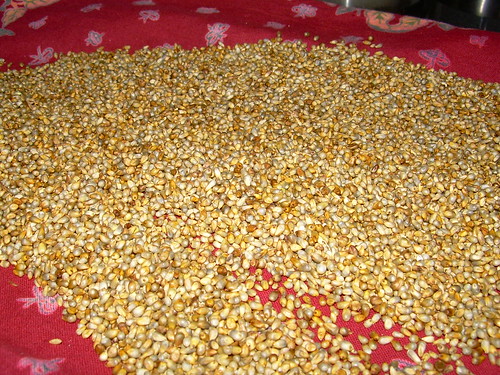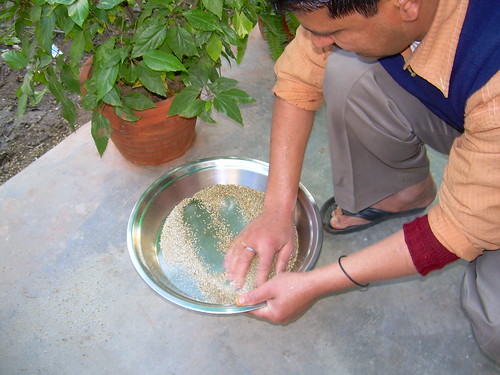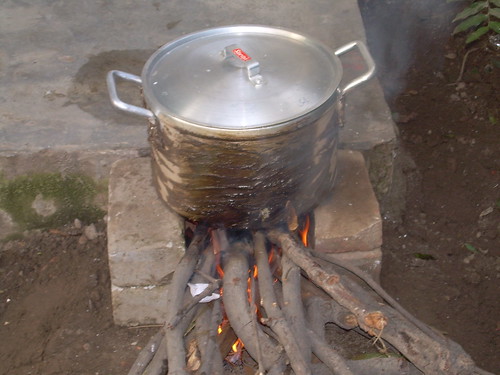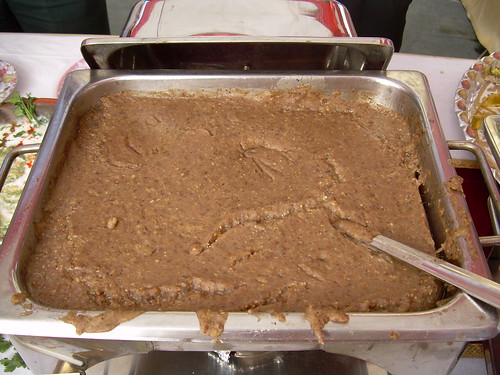Note: was posted on 9th Feb
Hello everyone. Thanks to everyone for visting and revisiting in the past 2 weeks....and basically waiting for me to get over a major bout of home sickness. I have been dying to post stuff for some time. But everytime I look at my pics from home........everything here seems to suck!
Anyway, no more whining. I promised to show you some of a 40-50 people bash (which eventually turned into a 100 person bash) at our place on Sankranti. Well, we had some cooks from outside come to our place and make some stuff...but mom insisted on doing the 'crucial dishes'. One most important one was Bajre ki Khicchdi- that is a mish-mash stew of a millet. This is an interesting crop since
a. it is perfectly suited for production in semi-arid regions of the country. Basically, it requires 1/3rd of the water that normal staples like wheat and rice would require.
b. It is highly nutritious vis. minerals. But not so much wrt to carbs. And hence it has been termed an inferior good- one whose consumption declines as people get richer and can shift to the more expensive wheat/rice.
c. It is making a huge comeback in the diets of middle-class (and above) Indians-- for both the above reasons. The reasoning that the Green Revolution that occured in Indian agriculture during the 1960s (which basically involved in large scale use of high yielding varieties of wheat and rice) is draining a lot from the soil and environment is starting to take root. And all of this is exacerbated as a renewed interest in rural and small town India that I have mentioned in a previous post.
Anyway, since we belong to a semi-arid (actually, plain arid region) of India, the use of bajra in various forms has always been part of our cuisine and rituals. Particularly during winter, since this millet is supposed to be very 'hot'-- it raises your body temperature when you eat it.

The way to make the stew is pretty labor intensive. The grain needs to be de-husked. That basically means either pounding it in a mortal or pestle or whirling it in a mixer for a few minutes, then removing the displaced husk by winnowing & sieving. And then repeating this process ad infinitum...........ok, at least 4 times. Here is Balbeer doing the dehusking.

Then you bung in the grain with triple the water and put it on a reaaaaaaaaly slow flame. In our case, this was a real, live, wooden stove in the backyard. The pot was coated on the outside with mud-water slurry in order to slow the cooking even more.

And after about 3-4 hours......you get Bajra Stew. It is traditionally eaten with Kadhi and mixed veggies in the winter. In the summer, instead of stew bajra is pounded to flour and flatbread (roti) is made.

Again, thanks for the great comments and thanks for checking in. More stuff soon..........hopefully. I wish I could shake this homesickness off.
3 comments:
I can do anything to eatt his!!!!! Looks awesome!!! :) Which place r u in btw?? :)
I have asnwered ur question on my blog. :)
Great, informative post. Hang in there w.r.t homesickness. If you would like a home-cooked meal, drive over anytime. You know where to find me!
Looks great like Italian Polenta or Ragi balls we make in K'taka!!I love the photos,I don't think I make all that at home here but great to see the traditional dishes as they are made.Beautiful, Thank you!:)
Hugs G!!Have a great weekend.
Post a Comment